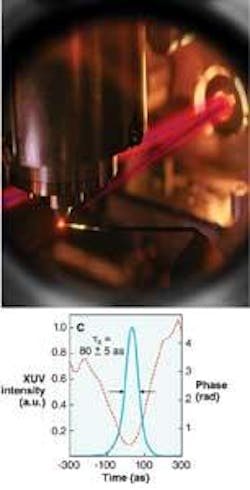ATTOSECOND PULSES: Light to reveal electrons interacting within atoms

By carefully controlling the waveform of an ultrafast laser pulse and sending it through a jet of neon gas, briefly ionizing it, researchers at the Max-Planck-Institut für Quantenoptik (MPQ; Garching, Germany), the Ludwig-Maxmilians-Universität (also in Garching), and the Lawrence Berkeley National Laboratory (Berkeley, CA) have created the shortest light pulse yet—only 80 attoseconds (as) in duration.1 Such well-controlled photoionization will result in new science, for example by allowing direct observation of quantum-electronic correlations.
The secret is in the consistent single-cycle nature of the incoming laser pulse. The carrier envelope of the 3.3-fs-long, 720 nm near-infrared (NIR) laser pulse has a somewhat Gaussian shape, and is short enough in duration that the one optical cycle closest to the peak of the envelope is much greater in intensity than any other part of the pulse. Because of this, the neon gas receives a single electric-field pulse powerful enough to ionize it, even if the peak of the envelope is not perfectly aligned with the peak of the optical cycle. The subsequent recollisions of the ionized electrons with the neon atoms produce the 80 as pulse, which is broadband with a peak in the extreme-ultraviolet (XUV) range (see figure).
To measure the pulse length, both the XUV pulse and the NIR laser pulse were shone into a second neon-gas jet so that the XUV pulse ionized the neon in the presence of the NIR light. Depending on when the electrons were ionized in relation to the arrival of the XUV pulse, the NIR pulse caused them to either gain or lose momentum, allowing the duration and other characteristics of the XUV pulse to be calculated from the energy distribution of the ionized electrons.
“Our approach can be best described as an optical-field streak camera, where the electric field of a laser pulse that rises from zero to its maximum value only within a few hundred attoseconds performs the streaking,” says Eleftherios Goulielmakis, project leader at the Laboratory of Attosecond and High-field Physics at the MPQ and in the Munich Center of Advanced Photonics. “Electrons released by the XUV pulse, essentially via the photoelectric effect, are streaked by the optical field and their kinetic energy is modified depending on the moment of their release in the optical field. We are able to retrieve the temporal structure of the emission by collecting electron spectra for different delays between the attosecond and the laser pulses and analyzing them with a frequency-resolved optical-gating (FROG) algorithm.”
Secondary emission
In addition to direct emission (enabling the measurement of attosecond pulses), secondary emission from atoms or molecules also can be studied temporally with this technique, like Auger decay, for example, notes Goulielmakis. In this case, a process is triggered by the ultrashort pulse while the secondary emission is a result of an ultrafast rearrangement of the electrons inside the atoms.
“Key results in our recent experiments—including the duration of our soft-x-ray pulses, as well as their enhanced photon yield, resulting in improved signal-to-noise ratio in our attosecond measurements—are parameters that reflect on the resolution of the technique,” says Goulielmakis. “We estimate our resolution to approach the atomic unit of time. This unit of time (24 as) represents the time scale on which one may expect the electron motions and their hyperfast interactions to unfold in the interior of the atoms. We hope that we will be able to see for the first time how electrons interact with each other inside atoms and to interrogate the role of their collective motion in the macroscopic behavior of matter. Consider, for example, the ionization of an atom or a molecule by a pulse of light. Whereas one electron is kicked off the atom, many others are left behind. How do these electrons rearrange themselves and generate a new equilibrium state? How do the electrons share the energy deposited into an atom by a photon? Questions of this type have not been asked so far due to the absence of appropriate tools to address them. We hope that sub-100 as pulses will allow us to address questions like the ones above, and at the same time to pave the way for controlling these processes in real-time.”
Further shortening light pulses would enable even more new scientific ground to be explored. “Pulses in the so called zeptosecond time scale (1 zeptosecond is 10-21 seconds) might also become available in the future,” says Goulielmakis. “This timescale is relevant to the proton and neutron motion inside the nuclei of atoms and therefore will open the door to capturing nuclear processes in real time.”
REFERENCES
1. E. Goulielmakis et al., Science 320 (June 20, 2008).
About the Author
John Wallace
Senior Technical Editor (1998-2022)
John Wallace was with Laser Focus World for nearly 25 years, retiring in late June 2022. He obtained a bachelor's degree in mechanical engineering and physics at Rutgers University and a master's in optical engineering at the University of Rochester. Before becoming an editor, John worked as an engineer at RCA, Exxon, Eastman Kodak, and GCA Corporation.
